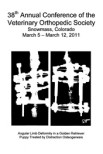OBJECTIVE: To describe a minimally invasive surgical technique for the treatment of comminuted humeral bicondylar (also known as T-Y) fractures in dogs and report outcome in 3 cases.
STUDY DESIGN: Surgical technique description and case report.
ANIMALS: Three consecutive dogs with traumatic comminuted humeral T-Y fractures.
METHODS: Dogs that presented with a traumatic humeral T-Y fracture were prospectively included. The condylar component of the fractures was reduced first by using a combination of percutaneous forceps and K-wires. A transcondylar screw was applied, and epicondylar pins were preplaced medially and laterally. The metaphyseal component of the fracture was then reduced and stabilized with the pins. Finally, a bone plate was applied percutaneously along the medial humeral surface. Intraoperative fluoroscopy was used throughout surgery in all cases. Postoperative alignment in the frontal and sagittal planes was compared to the contralateral limbs. Time to clinical union, clinical outcome, and complications were recorded.
RESULTS: Three dogs were included. Body weight ranged from 5.9 to 40 kg. Incomplete ossification of the humeral condyle was identified as the primary pathology leading to the fracture in 2 cases. All cases experienced uncomplicated healing with good to excellent functional recovery.
CONCLUSION: The reported technique was associated with good outcomes without complications in 3 cases.
CLINICAL SIGNIFICANCE: This study provides evidence that minimally invasive plate osteosynthesis represents an alternative to open reduction and internal fixation in the treatment of comminuted humeral T-Y fractures.









